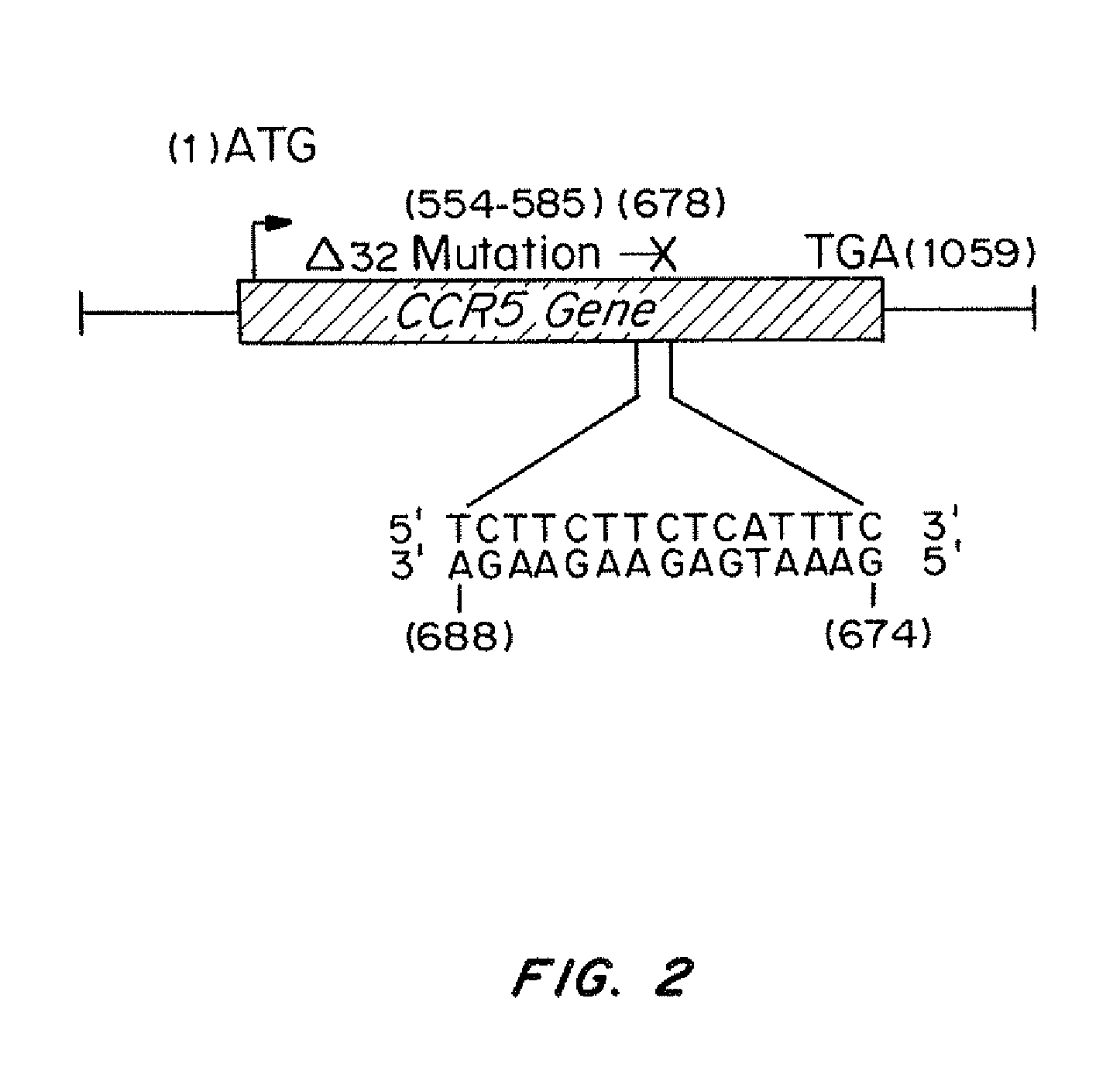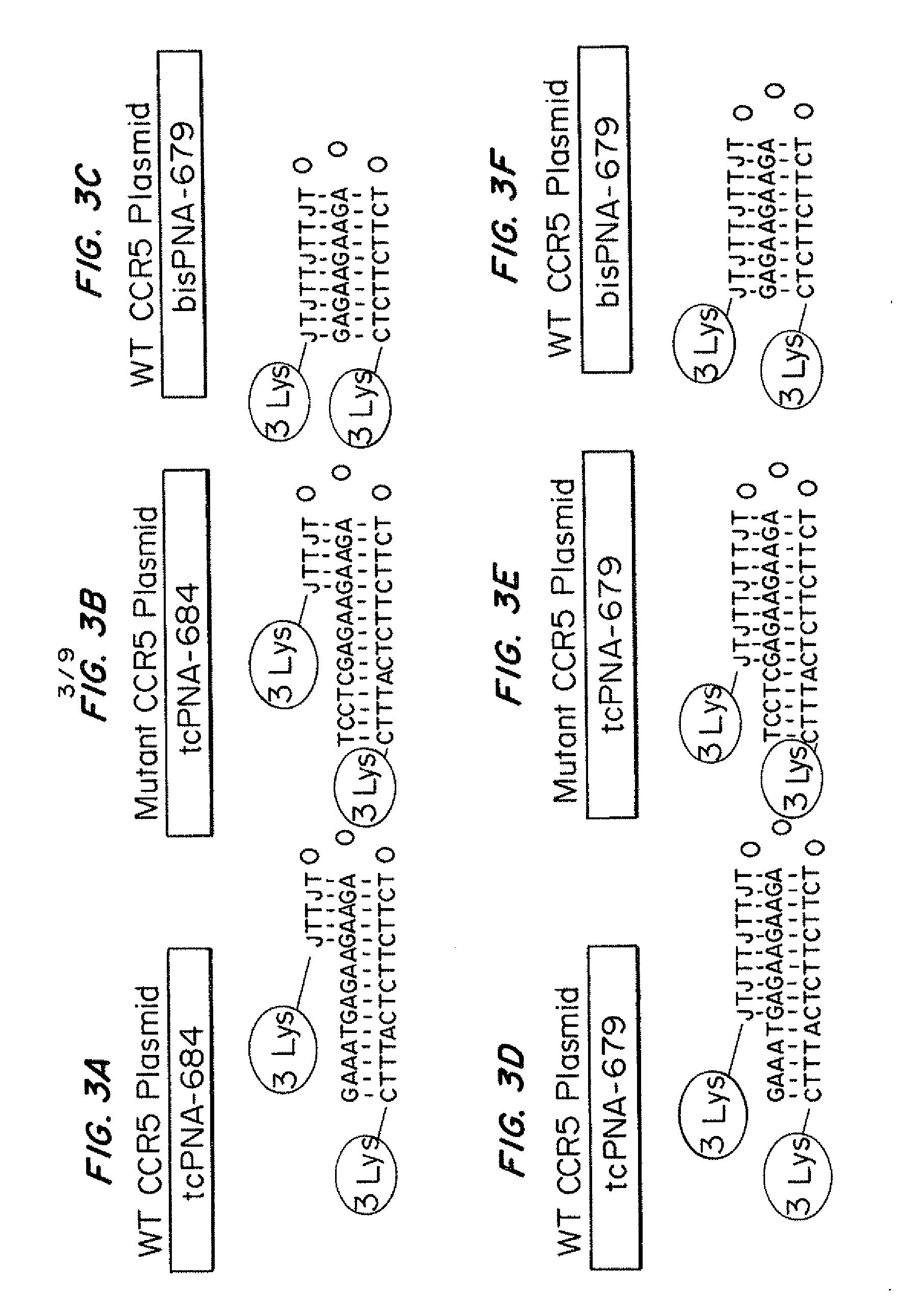Compositions and methods for targeted inactivation of HIV cell surface receptors
a technology of cell surface receptors and compositions, applied in the field of compositions, can solve the problems of toxicity, efficacy and drug resistance, complex delivery systems, and inability to target the receptors, and achieve the effect of reducing the viral load of an individual already, and preventing infection of an individual
- Summary
- Abstract
- Description
- Claims
- Application Information
AI Technical Summary
Benefits of technology
Problems solved by technology
Method used
Image
Examples
example 1
Sequence Specific PNAs Bind the CCR5 Gene on a Plasmid Substrate
[0161]Materials and Methods
[0162]Design and Synthesis of PNAs and Donor Oligonucleotides
[0163]PNA-679 (sequence from N-terminus to C-terminus-Lys-Lys-Lys-JTJTTJTTJT-OOO-TCTTCTTCTC-Lys-Lys-Lys (SEQ ID NO: 3)); tcPNA-679 (sequence from N-terminus to C-terminus-Lys-Lys-Lys-JTJTTJTTJT-OOO-TCTTCTTCTCATTTC-Lys-Lys-Lys (SEQ ID NO: 5)), and tcPNA-684 (sequence from N-terminus to C-terminus-Lys-Lys-Lys-JTTJT-OOO-TCTTCTTCTCATTTC-Lys-Lys-Lys (SEQ ID NO: 7)) to the polypurine target site in CCR5. J=pseudoisocytosine. Three lysine residues were conjugated to both the N and C terminal ends of the PNA for increased bioactivity and 8-amino-2,6-dioxaoctanoic acid linkers were used as the flexible linker “O.” PNAs are depicted in FIGS. 1A-1C without 3× lysine caps at each end.
[0164]DNA oligonucleotides were synthesized by the Midland Certified Reagent Company Inc. (Midland, Tex.) and purified by RP-HPLC. The sequences of the DNA oligonuc...
example 2
Targeted Modification of the CCR5 Gene and Quantification in Human Cells
[0170]Materials and Methods
[0171]Cell Culture
[0172]THP-1 cells were maintained in RPMI supplemented with 10% FBS and L-Glutamine (GIBCO, Invitrogen, Carlsbad, Calif.). Human CD34+ stem cells were isolated from apheresis of granulocyte colony stimulating-factor (G-CSF) mobilized peripheral blood from healthy donors and then selected for using a Baxter 300i Isolex Device and cryopreserved (Yale Center of Excellence in Molecular Hematology, Yale University). Cells were thawed and maintained in StemSpan Serum-Free Expansion Media® supplemented with StemSpan™ CC110 cytokine mixture (100 ng / mL rh Flt-3 Ligand, 100 ng / mL rh Stem Cell Factor, 20 ng / mL rh IL-3, 20 ng / mL rh IL-6, StemCell Technologies Inc., Vancouver, BC Canada). THP-1 differentiation was induced by treatment with phorbol 12-myristate 13-acetate (PMA) (Sigma, St. Louis, Mo.) at a concentration of 50 ng / mL.
[0173]Electroporation of Molecules
[0174]THP-1 cell...
example 3
Persistence of PNA-Induced Modification of CCR5
[0185]Materials and Methods
[0186]Allele-Specific Reverse Transcriptase PCR
[0187]Primers were designed to amplify a 667-bp region in CCR5. The allele-specific reverse primer was designed to contain the specific 6-bp mutation at the 3′ end while the wild-type reverse primer contained the wild-type CCR5 sequence. Forward primers were designed to bind in exon 2 with the reverse primer binding within exon 3, allowing for specific identification of cDNA as opposed to genomic DNA amplified products. The PCR products were separated on a 1% agarose gel and visualized using a gel imager. The forward primer paired with the wild-type reverse primer was used as a loading control.
[0188]Results
[0189]Reproducible CCR5 gene targeting was seen not only in THP-1 cells but also in another human cell line, K562, as determined by allele-specific PCR of 597 mutation in genomic DNA isolated from both cell types. Treated cells were also analyzed at the mRNA lev...
PUM
| Property | Measurement | Unit |
|---|---|---|
| volume | aaaaa | aaaaa |
| concentration | aaaaa | aaaaa |
| volume | aaaaa | aaaaa |
Abstract
Description
Claims
Application Information
 Login to View More
Login to View More - R&D
- Intellectual Property
- Life Sciences
- Materials
- Tech Scout
- Unparalleled Data Quality
- Higher Quality Content
- 60% Fewer Hallucinations
Browse by: Latest US Patents, China's latest patents, Technical Efficacy Thesaurus, Application Domain, Technology Topic, Popular Technical Reports.
© 2025 PatSnap. All rights reserved.Legal|Privacy policy|Modern Slavery Act Transparency Statement|Sitemap|About US| Contact US: help@patsnap.com



